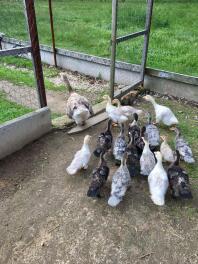African History
This is the only other domestic goose breed (the other being the Chinese) that does not have the European Greylag goose (Anser anser) as its ancestor. Instead it is a descendant of the Asiatic Swan goose ( Anser cygnoides) but is a much bigger and heavier bird than the Chinese goose. It does not originate from Africa as its name suggests but from China and it arrived in the UK and USA via the ever increasing trade routes in the 19th century. It was admitted to the American Poultry Association's Standard of Perfection in 1879. The first poultry show in the UK was held in 1845 and had classes for Asiatic or Knob geese which would have included the African. It had a resurgence of interest in the 1980s and was classified in the UK in 1982. It's a favourite amongst exhibitors although it requires an extra large show pen for its impressive size.
African Behaviour
Despite its size it is a calm and gentle bird (it can stand as hight as a metre high). They need size both in housing and outside in order to keep fit and forage and they do eat more than other breeds due to their size but care must be taken not to allow them to get too fat. They need water especially for mating and because they are large birds with big feet, the ground needs to be well drained and they must not be over stocked. Although the goose likes to brood, there is a real risk of her squashing her goslings so for safety use an incubator. As with the Chinese it is a vocal bird but not so loud or persistent. It lays around 30 eggs a year. Now it is mainly kept for its impressive performance on the show bench.
Appearance
The head of the African goose is distinctive – it is large and broad with a knob protruding from the front of the skull, normally larger in ganders than geese. The lower jaw and top of the neck support a large dewlap which is curved. It comes in Brown or Grey, Buff and White. In the Brown or Grey, both sexes have dark brown eyes and dark orange or brownish orange legs. There is a distinctive brown stripe from the crown of the head down the back of the neck. The back and sides of the body are coloured while the breast and underbody are light fawn.
It is a heavy breed.
It takes time and effort to breed and care for these majestic birds so expect the price to reflect this.
African Status
Common
African For Sale
Please note:
All animals listed here are for collection only. They cannot be delivered by the seller or by Omlet. The seller will send you their contact details to arrange payment and collection.
Sorry, there are currently no African listed for Sale
Latest Reviews For African
There are not yet any reviews for this breed. Click
here to write one.
